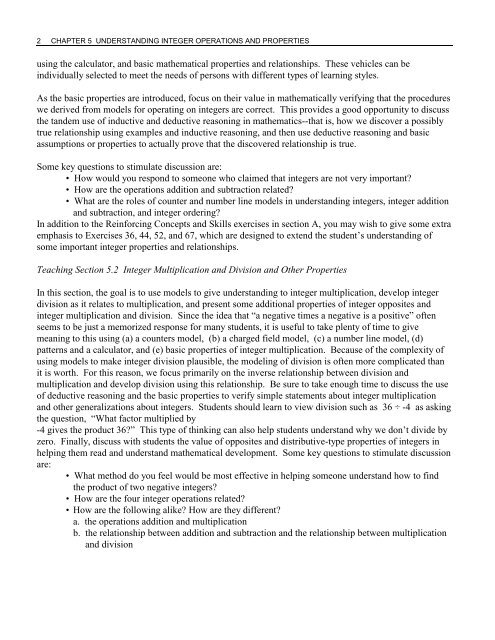CHAPTER 2. Understanding Whole-Number Operations and ...
CHAPTER 2. Understanding Whole-Number Operations and ...
CHAPTER 2. Understanding Whole-Number Operations and ...
Create successful ePaper yourself
Turn your PDF publications into a flip-book with our unique Google optimized e-Paper software.
2 <strong>CHAPTER</strong> 5 UNDERSTANDING INTEGER OPERATIONS AND PROPERTIES<br />
using the calculator, <strong>and</strong> basic mathematical properties <strong>and</strong> relationships. These vehicles can be<br />
individually selected to meet the needs of persons with different types of learning styles.<br />
As the basic properties are introduced, focus on their value in mathematically verifying that the procedures<br />
we derived from models for operating on integers are correct. This provides a good opportunity to discuss<br />
the t<strong>and</strong>em use of inductive <strong>and</strong> deductive reasoning in mathematics--that is, how we discover a possibly<br />
true relationship using examples <strong>and</strong> inductive reasoning, <strong>and</strong> then use deductive reasoning <strong>and</strong> basic<br />
assumptions or properties to actually prove that the discovered relationship is true.<br />
Some key questions to stimulate discussion are:<br />
How would you respond to someone who claimed that integers are not very important?<br />
How are the operations addition <strong>and</strong> subtraction related?<br />
What are the roles of counter <strong>and</strong> number line models in underst<strong>and</strong>ing integers, integer addition<br />
<strong>and</strong> subtraction, <strong>and</strong> integer ordering?<br />
In addition to the Reinforcing Concepts <strong>and</strong> Skills exercises in section A, you may wish to give some extra<br />
emphasis to Exercises 36, 44, 52, <strong>and</strong> 67, which are designed to extend the student’s underst<strong>and</strong>ing of<br />
some important integer properties <strong>and</strong> relationships.<br />
Teaching Section 5.2 Integer Multiplication <strong>and</strong> Division <strong>and</strong> Other Properties<br />
In this section, the goal is to use models to give underst<strong>and</strong>ing to integer multiplication, develop integer<br />
division as it relates to multiplication, <strong>and</strong> present some additional properties of integer opposites <strong>and</strong><br />
integer multiplication <strong>and</strong> division. Since the idea that “a negative times a negative is a positive” often<br />
seems to be just a memorized response for many students, it is useful to take plenty of time to give<br />
meaning to this using (a) a counters model, (b) a charged field model, (c) a number line model, (d)<br />
patterns <strong>and</strong> a calculator, <strong>and</strong> (e) basic properties of integer multiplication. Because of the complexity of<br />
using models to make integer division plausible, the modeling of division is often more complicated than<br />
it is worth. For this reason, we focus primarily on the inverse relationship between division <strong>and</strong><br />
multiplication <strong>and</strong> develop division using this relationship. Be sure to take enough time to discuss the use<br />
of deductive reasoning <strong>and</strong> the basic properties to verify simple statements about integer multiplication<br />
<strong>and</strong> other generalizations about integers. Students should learn to view division such as 36 ÷ -4 as asking<br />
the question, “What factor multiplied by<br />
-4 gives the product 36?” This type of thinking can also help students underst<strong>and</strong> why we don’t divide by<br />
zero. Finally, discuss with students the value of opposites <strong>and</strong> distributive-type properties of integers in<br />
helping them read <strong>and</strong> underst<strong>and</strong> mathematical development. Some key questions to stimulate discussion<br />
are:<br />
What method do you feel would be most effective in helping someone underst<strong>and</strong> how to find<br />
the product of two negative integers?<br />
How are the four integer operations related?<br />
How are the following alike? How are they different?<br />
a. the operations addition <strong>and</strong> multiplication<br />
b. the relationship between addition <strong>and</strong> subtraction <strong>and</strong> the relationship between multiplication<br />
<strong>and</strong> division
















